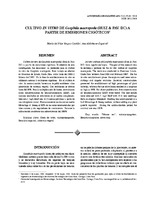Mostrar el registro sencillo del ítem
Cultivo in vitro de Geophila macropoda (Ruiz & Pav.DC) a partir de embriones cigóticos
| dc.contributor.author | Vargas-Castillo, Pilar | |
| dc.contributor.author | Abdelnour-Esquivel, Ana | |
| dc.date.accessioned | 2017-05-31T19:49:26Z | |
| dc.date.available | 2017-05-31T19:49:26Z | |
| dc.date.issued | 2010 | |
| dc.identifier | https://www.mag.go.cr/rev_meso/v21n01_073.pdf | es |
| dc.identifier.citation | Vargas-Castillo, María del Pilar, Abdelnour-Esquivel, Ana. Agronomía Mesoamericana. Volumen 21, N°1. P. 73-83. Mayo, 2010. | es |
| dc.identifier.issn | 1021-7444 | |
| dc.identifier.uri | https://hdl.handle.net/2238/7122 | |
| dc.description.abstract | El objetivo de esta investigación fue desarrollar un protocolo para el cultivo in vitro de Geophila macropoda. Este trabajo se efectuó en Guácimo de Limón, Costa Rica, entre junio del 2006 y febrero del 2007. En la fase de establecimiento in vitro se utilizaron estacas y embriones cigóticos. En el cultivo in vitro, la contaminación bacteriana impidió establecer altos porcentajes de material vegetal. Con embriones se obtuvo hasta del 89%. Para la multiplicación de brotes, se evaluaron cinco concentraciones de bencilaminopurina (BAP). Los mejores resultados se obtuvieron en el medio complementado con 2 mg/l BAP con 13,4 nuevas plántulas a partir de una vitroplanta inicial. El enraizamiento se alcanzó en medio Murashige & Skoog al 50% de las sales recomendadas por tales autores y sin reguladores de crecimiento. Durante la aclimatación se obtuvo una sobrevivencia del 100%. | es |
| dc.description.abstract | The goal of this research was to develop a protocol for the in vitro culture of Geophila macropoda. The work was conducted in Guácimo, Limón, Costa Rica between June 2006 and February 2007. For the in vitro establishment phase, the explants used were microcuttings and zygotic embryos. Bacterial contamination prevented the establishment of high percentages of plant material, whereas the use of embryos resulted in a response as high as 89%. For shoot proliferation, five concentrations of benzilaminopurine (BAP) were tested. The best results were obtained with 2 mg/l BAP with 13.4 new seedlings from an original vitroplant. Rooting was accomplished in a half Murashige & Skoog medium, without adding any plant growth regulator. During the acclimatization period the survival rate was 100%. | |
| dc.language.iso | spa | es |
| dc.source | Agronomía Mesoamericana. Volumen 21, N°1. P. 73-83 | es |
| dc.subject | Oreja de ratón | es |
| dc.subject | Micropropagación | es |
| dc.subject | Bencilaminopurina | es |
| dc.subject | Cobertura vegetal | es |
| dc.subject | Embriones | es |
| dc.subject | Research Subject Categories::NATURAL SCIENCES::Biology::Organism biology::Microbiology | es |
| dc.subject | Cultivo in vitro | |
| dc.subject | Geophila macropoda | |
| dc.subject | Micropropagation | |
| dc.subject | Benzyl aminopurine | |
| dc.subject | Vegetative coverage | |
| dc.subject | Embryos | |
| dc.subject | In vitro culture | |
| dc.title | Cultivo in vitro de Geophila macropoda (Ruiz & Pav.DC) a partir de embriones cigóticos | es |
| dc.type | info:eu-repo/semantics/article | es |
Ficheros en el ítem
Este ítem aparece en la(s) siguiente(s) colección(ones)
-
Artículos [39]


